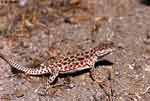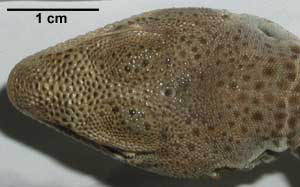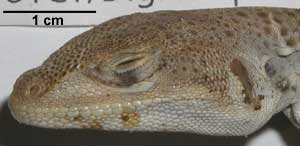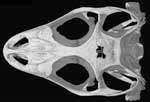|
|
Gambelia wislizenii, the long-nosed leopard lizard, occurs across the western United States from Idaho and Oregon in the north, south to northern México in Baja California, Sonora, Coahuila, and Zacatecas. It is considered to be one of four 'ubiquitous' lizards of the western deserts and is the most widely distributed member of the genus. G. wislizenii inhabits desert flats and lower foothills with sparse vegetation, frequently sheltering in rodent burrows or digging their own if the soil is suitable. Leopard lizards prey on smaller lizards, insects, and small rodents, and also consume a small quantity of plant material. They are facultative bipeds, running on their hind legs to escape predators.
|
| The coloration of Gambelia wislizenii varies during the day, becoming dark when the animal is cool. Coloration also varies during the year: female leopard lizards take on a dramatic coloration during the breeding season. |
Gambelia wislizenii is a member of Crotaphytidae, an exclusively North American group that also includes Crotaphytus, the collared lizards. Crotaphytidae includes 10-11 species, occurring in southwestern North America from eastern Oregon to the Mississippi River and south to northern México. Crotaphytids have the ability to vocalize, a rare feature among squamates that otherwise occurs only in gekkotans and some polychrotids (anoles). This vocalization is generally a squealing sound emitted during periods of stress. Members of Crotaphytidae are diagnosed by the following characters (among others; see McGuire, 1996), most of which are visible in the animations above: prefrontal contacts jugal; parietal and frontal strongly overlap postorbital; jugal-ectopterygoid tubercle present; and tympanic crest of retroarticular process curves posteroventrally.

About the Species
This frozen specimen was collected from Mojave Desert National Preserve, San Bernadino County, California by Jacques Gauthier. It was made available to the University of Texas High-Resolution X-ray CT Facility for scanning by Dr. Jessie Maisano of The University of Texas and Dr. Jacques Gauthier of Yale University. Funding for scanning was provided by an NSF grant (DEB-0132227) to Dr. Jack Sites of Brigham Young University. Funding for image processing was provided by a National Science Foundation Assembling the Tree of Life grant (EF-0334961), The Deep Scaly Project: Resolving Squamate Phylogeny using Genomic and Morphological Approaches, to Drs. Jacques Gauthier of Yale University, Maureen Kearney of the Field Museum, Jessie Maisano of The University of Texas at Austin, Tod Reeder of San Diego State University, Olivier Rieppel of the Field Museum, Jack Sites of Brigham Young University, and John Wiens of SUNY Stonybrook.

About this Specimen
The specimen was scanned by Matthew Colbert on 21 December 2002 along the coronal axis for a total of 720 slices, each slice 0.0417 mm thick with an interslice spacing of 0.0417 mm.

About the
Scan
Literature
Frost, D. R., and R. Etheridge. 1989. A phylogenetic analysis and taxonomy of iguanian lizards (Reptilia: Squamata). University of Kansas Museum of Natural History Miscellaneous Publication 81:1-65.
McGuire, J. A. 1996. Phylogenetic systematics of crotaphytid Lizards (Reptilia: Iguania: Crotaphytidae). Bulletin of the Carnegie Museum of Natural History 32:1-142.
Nussbaum, R. A., E. D. Brodie, Jr., and R. M. Storm. 1983. Amphibians and Reptiles of the Pacific Northwest. The University Press of Idaho.
Orange, D. I., B. R. Riddle, and D. C. Nickle. 1999. Phylogeography of a wide-ranging desert lizard, Gambelia wislizenii (Crotaphytidae). Copeia 1999:267-273.
Parker, W. S., and E. R. Pianka. 1976. Ecological observations on the leopard lizard (Crotaphytus wislizeni) in different parts of its range. Herpetologica 32:95-114.
Robison, W. G., Jr., and W. W. Tanner. 1962. A comparative study of the species of the genus Crotaphytus Holbrook (Iquanidae). Brigham Young University Science Bulletin 2:1-31.
Links
Gambelia wislizenii page from the San Diego Natural History Museum Field Guide
Crotaphytidae page from the EMBL Reptile Database

Literature
& Links
Three-dimensional volumetric renderings of the skull with the scleral ossicles, hyoid and jaw removed, and of the isolated left mandible. All are less than 2mb.

Additional Imagery
 |
|















